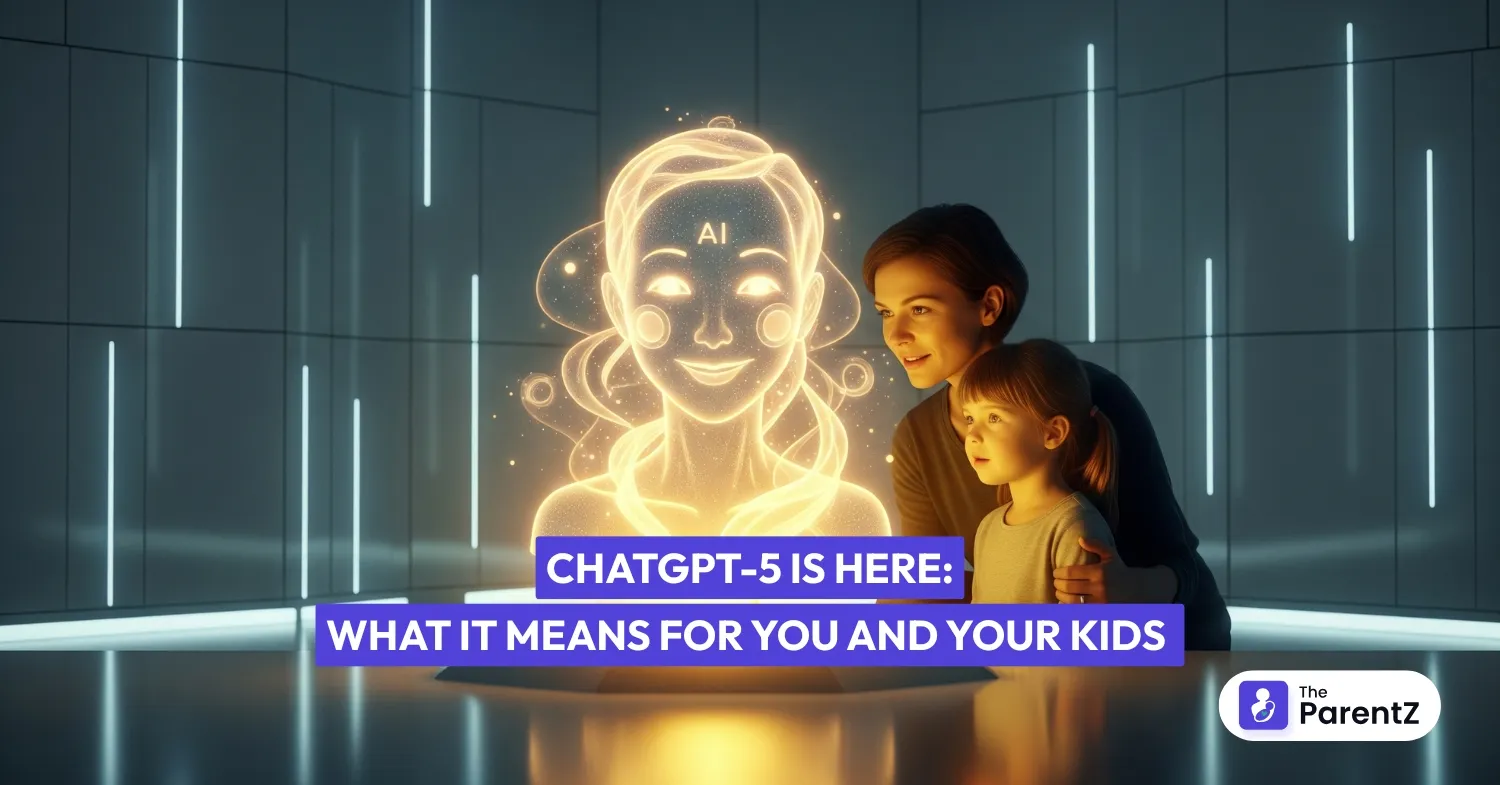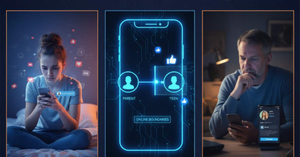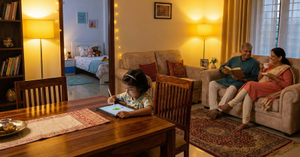Your 14-year-old just walked into the kitchen and announced they "built an app" during lunch break. Your 10-year-old is having what sounds like a genuine conversation with their computer. Your teenager's homework suddenly looks suspiciously well-written, and you're not sure if you should be impressed or concerned.
Welcome to the ChatGPT-5 era.
And here's the thing: your kids are already using it, whether you know it or not. And unlike that time you discovered they'd been on Snapchat for months without telling you, this one actually has the potential to help them learn, create, and solve problems in ways that seemed like science fiction just a few years ago.
What's Different About ChatGPT-5?
Think of ChatGPT-5 like getting a major upgrade on your phone. Everything works better, faster, and can do more things. But let's get specific about what your family will actually notice.
- Smarter Conversation System: ChatGPT-5 now has what's called a "real-time router" that automatically figures out how complex your question is and responds accordingly. When your kid asks a simple math question, it gives a quick answer. When they ask something complicated like "help me understand why World War I started," it switches to a deeper thinking mode and gives a more thorough explanation.
- Voice Conversations That Sound Real: The new voice feature is honestly a little scary, how human it sounds. Your kids can now have actual spoken conversations with ChatGPT, and it responds in real-time like they're talking to a person.
- Picture Powers: ChatGPT-5 can now look at photos and understand what's in them much better. Your kid could take a picture of their messy room and ask for organization tips, or snap a photo of a math problem from their textbook and get step-by-step help. It can also create images based on descriptions, so if they're working on a school project about ancient Egypt, they could ask for a historically accurate illustration of a pyramid being built.
- Coding Made Simple: If your teenager shows any interest in building apps or websites, ChatGPT-5 can now actually create working code that they can use immediately. It's not just giving them snippets anymore – it can build entire simple apps, games, or websites from scratch based on their ideas. Your kid could literally say, "I want to make a website for my dog-walking business," and get something that actually works.
- Study Mode That Actually Teaches: Instead of just giving answers, the new study mode asks your kids questions back. If they ask, "What's photosynthesis?" it might respond with "Great question! Let's figure this out together. What do you think plants need to survive?" This helps them learn the concept instead of just memorizing an answer.
- Health Information: ChatGPT-5 has been specifically trained to handle health questions better. If your child asks about a weird bump or rash, it can help them understand what questions to ask you or the doctor, rather than just guessing what it might be. But it's very clear about not being a replacement for real medical advice.
- Better Memory Within Conversations: Unlike before, ChatGPT-5 remembers everything from your conversation much better. If your kid is working on a multi-day project, they can pick up where they left off without having to re-explain everything.
- Fewer Made-Up Facts: This was a big problem with earlier versions. The AI would sometimes just invent information that sounded believable. ChatGPT-5 is much better at saying "I don't know" when it doesn't actually know something, and it's more accurate overall when it does provide facts.
How Your Kids Are Probably Using It
If your kids know about ChatGPT, they're likely already using it. Here's what they're probably doing with the new features:
- Homework Help: Your middle schooler might ask it to explain a math concept or help brainstorm ideas for an essay. The good news? The new "study mode" actually tries to teach them by asking questions back instead of just giving answers.
- Creative Projects: That story your daughter is writing? She might be bouncing ideas off ChatGPT or asking it to help her think through character development.
- Learning New Skills: Your son, who's interested in making videos or learning guitar, might be asking ChatGPT for step-by-step guidance.
- Just Chatting: Some kids find it fun to have conversations with AI, especially the new voice feature that sounds more like talking to a person.
The Conversations You Need to Have
This is where the parenting part comes in. You don't need to become an AI expert overnight, but you do need to have some honest talks with your kids.
- Start with the basics: ChatGPT isn't a person. We know that it sounds obvious, but the new version is so good at conversation that it can feel like texting with a friend. Your kids need to understand they're talking to a computer program, not a human being.
- Talk about fact-checking: Even though ChatGPT-5 is more accurate, it still makes mistakes. Teach your kids the same thing you'd teach them about Wikipedia: that it's a great starting point, but always double-check important information, especially for school projects.
- Discuss the health stuff: The new version can answer health questions, but make it clear that weird symptoms, concerns, or worries should come to you first, not to an AI. ChatGPT even says it's not a doctor, but kids might not always remember that in the moment.
- Set boundaries around emotional support: This one's tricky. Some kids might start treating ChatGPT like a friend or therapist, especially if they're going through a tough time. While it can be helpful for working through thoughts, it shouldn't replace real human connection and support.
Practical Safety Tips
Here are some concrete things you can do right now:
- Use it together: Sit down with your kids and explore ChatGPT-5 together. Ask it to help you plan a family vacation or explain something you're both curious about. This way, you understand what they're working with, and they see you as someone who gets it.
- Create family guidelines: Just like you might have rules about screen time or social media, create some basic rules about AI use. Maybe it's "always fact-check before turning in homework" or "ask Mom or Dad before using it for health questions."
- Check privacy settings: Like any online tool, make sure you understand what information is being shared and stored. The good news is that ChatGPT doesn't learn from individual conversations, but it's still worth understanding how it works.
- Stay involved in school stuff: If your child uses ChatGPT for homework, make sure they understand their school's policies. Many schools are still figuring out their AI rules, and you don't want your kid accidentally breaking guidelines they didn't know about.
The Bigger Picture
ChatGPT-5 parenting isn't just about managing a new app; it's about helping your kids develop good relationships with technology that's going to be part of their lives forever. This stuff isn't going anywhere, and the kids who learn to use it wisely now will have a real advantage later.
Think of it like teaching them to drive. You don't hand over the keys and hope for the best. You sit in the passenger seat, give guidance, set rules, and gradually let them take more control as they prove they can handle it.
The same approach works with AI tools for families. Start involved, stay curious about what they're doing, and adjust the rules as they get older and more responsible.
What About Younger Kids?
If you have elementary-age kids who are curious about ChatGPT, that's actually a great opportunity. The new version has better safety features, but younger kids definitely need more supervision.
Consider using it as a family activity. Ask ChatGPT to help create a bedtime story, plan a weekend activity, or explain why the sky is blue. This way, your kids see it as a useful tool that families use together, not something secretive or off-limits.
Conclusion
The reality is that AI is becoming as common as smartphones or social media. The key is staying engaged. You don't have to become a tech expert, but you do need to be curious and involved. Ask your kids to show you what they're working on. Try ChatGPT yourself for something you're interested in. The more comfortable you are with it, the better you can guide your family's use.








Be the first one to comment on this story.